Samsung SSD 840 Pro (256GB) Review
by Anand Lal Shimpi on September 24, 2012 7:00 AM EST- Posted in
- Storage
- SSDs
- Samsung
- Samsung SSD 840
AnandTech Storage Bench 2011 - Light Workload
Our new light workload actually has more write operations than read operations. The split is as follows: 372,630 reads and 459,709 writes. The relatively close read/write ratio does better mimic a typical light workload (although even lighter workloads would be far more read centric).
The I/O breakdown is similar to the heavy workload at small IOs, however you'll notice that there are far fewer large IO transfers:
| AnandTech Storage Bench 2011 - Light Workload IO Breakdown | ||||
| IO Size | % of Total | |||
| 4KB | 27% | |||
| 16KB | 8% | |||
| 32KB | 6% | |||
| 64KB | 5% | |||
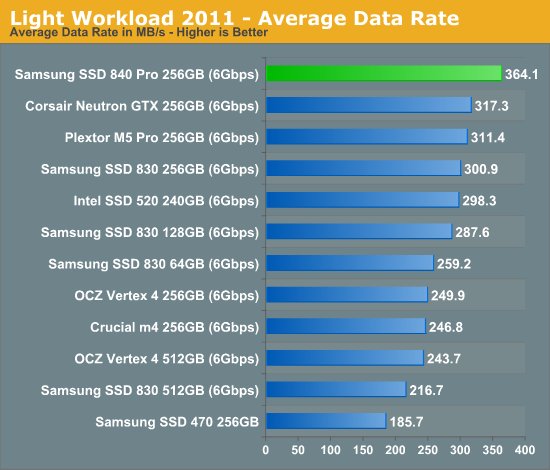
The 840 Pro shows a similar ~20% increase in performance over the 830 in our light suite. Corsair's Neutron GTX is more competitive, but nothing can really touch the 840 Pro here.

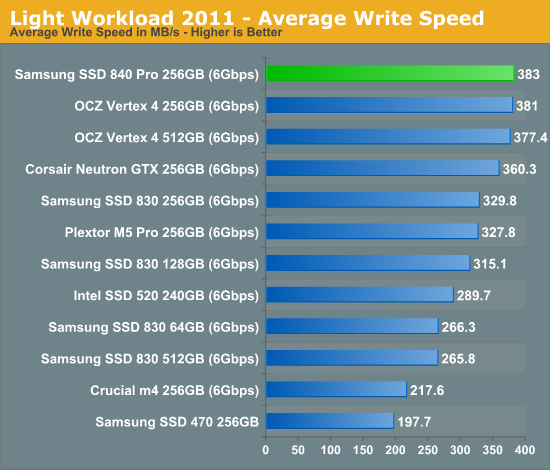
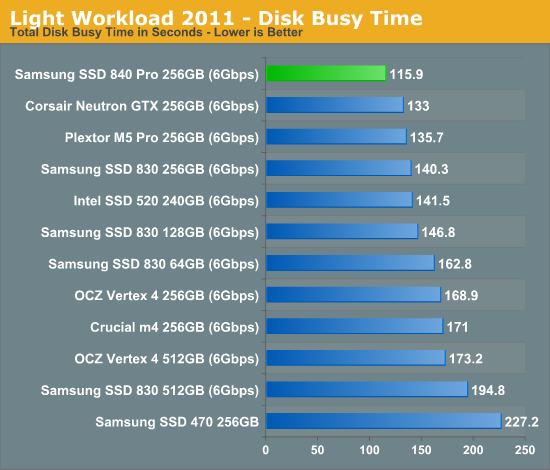
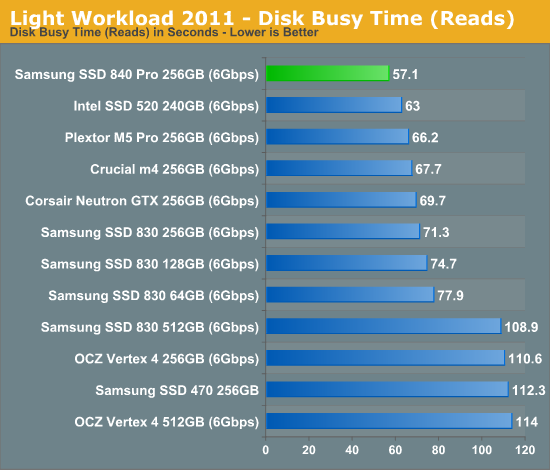
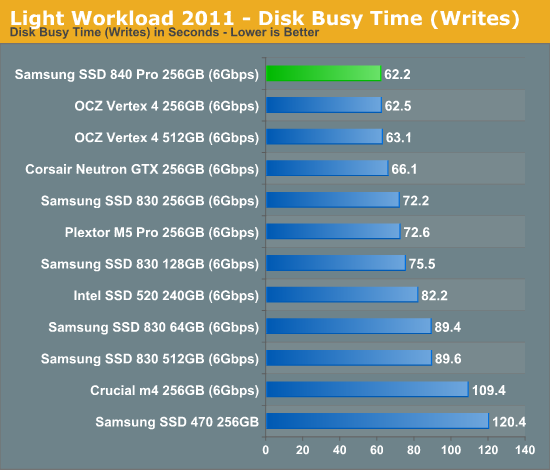










96 Comments
View All Comments
Old_Fogie_Late_Bloomer - Monday, September 24, 2012 - link
I think I might move my Steam folder to my 64GB 830 (if it hasn't grown too large) and see if Portal II level load times improve. The write times take a hit due to the smaller number of NAND chips, but the read times should be mostly limited by SATA 3 bandwidth. I'll try to pop back in here with a report of any improvements that I see.Old_Fogie_Late_Bloomer - Tuesday, September 25, 2012 - link
Long story short, despite the fact that the 830 64GB beats out the 320 160GB in seven of eight CrystalDiskMark tests (88% in sequential reading, 95% in 512K random read, and so on, except for 4K random write with a queue depth of 32, where the Intel is 70% faster)......I honestly can't say it takes noticeably less time to either load games like Portal, Portal 2, or Quantum Conundrum, or to load levels/saves in those games. Portal 2 might start up a tiny bit faster on the new drive, but I certainly wouldn't swear to it.
repoman27 - Monday, September 24, 2012 - link
The article mentions that this drive uses the new Toggle 2.0 interface which operates at 400 Mbps, however individual packages are clearly capable of more than that if 8 packages can provide sequential speeds greater than 400 MB/s.My understanding is that both ONFI 3.0 and Toggle 2.0 support data rates of 400 MT/s. It would seem that the maximum transfer size for ONFI is 8 bits, so they claim 400 MB/s for the interface. Is the 400 Mbps number for Toggle 2.0 a per die figure? Is it not also capable of 8 bits per transfer and thus 400 MB/s as well?
Kristian Vättö - Monday, September 24, 2012 - link
400Mbit/s is the speed of the Toggle-Mode 2.0 interface but the the interface is 8 bits wide, making the maximum throughput 400MB/s per interface. I know it's stupid that they say 400Mbps because it's just confusingMrMilli - Monday, September 24, 2012 - link
"The basic architecture of the controller hasn't changed. Internally there are three ARM9 cores now running at 300MHz."It's not using ARM9 cores any longer. It's now using Cortex R4 cores. I would say that's a big enough change to say that the basic architecture has changed.
Kristian Vättö - Monday, September 24, 2012 - link
You are correct. Samsung's reviewer's guide originally said ARM9 but yesterday's slides said ARM R4, hence the confusion here :-)Jocelyn - Monday, September 24, 2012 - link
Thank You for the review Anand, but is there any chance you and Kristian could start controlling the variables that are not being tested in future SSD reviews? CPU power saving features (EIST/Turbo) being left on in some reviews, while off in others, definitely affects performance.jwcalla - Monday, September 24, 2012 - link
I have yet to see an SSD that gets better than 75% of the SATA theoretical max -- even SATA II drives. Can the interface really have 25% lost to inefficiencies? That seems like a lot of overhead.repoman27 - Monday, September 24, 2012 - link
SATA uses 8b/10b encoding, so 6Gb/s becomes 600MB/s. Then, just like any transfer protocol, there's additional protocol overhead. The AS-SSD sequential read speeds posted by this drive would demonstrate just better than 85% efficiency, which is not too shabby.Oxford Guy - Monday, September 24, 2012 - link
"The first Samsung MLC SSDs were reliable, they just weren't worth the money when you had much better options from companies like Intel."Intel stuck it to X25M G1 owners by refusing to provide a firmware update to support TRIM. If you're going to praise Intel and criticize Samsung so much in the opening of an article, that should have been noted.